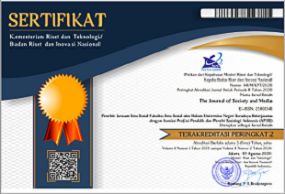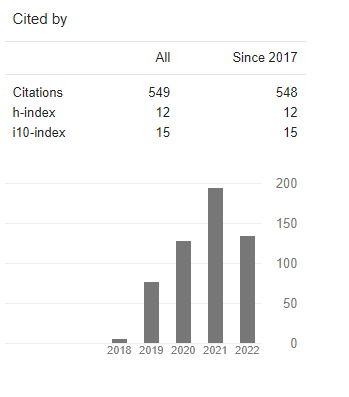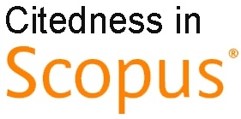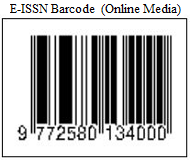The Role of Social Identity, State Ideology, and Digital War Narratives of a Russian Military Blogger on Telegram
DOI:
https://doi.org/10.26740/jsm.v9n1.p174-202Keywords:
content analysis, military blogger, social identity, social categorizationAbstract
Along with the cyber war and media manipulation under government control since the Russian military operation in Ukraine in February 2022, the Russian government has blocked public access to popular Western social media, such as Instagram, Facebook, and Twitter. As a result, a Russia-based social media called Telegram gained popularity and is used by pro-Russian military bloggers to spread awareness of the issue that was currently in focus among society. This research seeks to explain the motivation underlying the dissemination of information on @maryananaumova Telegram channel. By utilizing content analysis methods, authors identified recurring content patterns dominated by accusations and expressions of hatred towards Ukraine, as well as Russia’s image branding narrative throughout April-May 2023. The findings of this research demonstrate that Maryana's national identity and political affiliation exert influence in shaping the narrative on the Telegram channel, which tends to prioritize the dignity of pro-Russian groups.
References
Abrams, D., and M.A. Hogg. 1990. “An Introduction to the Social Identity Approach.” Pp. 1–9 in Social Identity Theory: Constructive and Critical Advances, edited by S. Worchel and W.G. Austin. New York: Springer.
Arnett, Dennis B., Steve D. German, and Shelby D. Hunt. 2003. “The Identity Salience Model of Relationship Marketing Success: The Case of Nonprofit Marketing.” Journal of Marketing 67(2):89–105. https://doi.org/10.1509/jmkg.67.2.89.18614.
Atanesian, G. 2023. “Ukraine War: Putin Influencers Profiting from War Propaganda.” BBC, September 2. Retrieved April 19, 2025 (https://www.bbc.com/news/world-europe-66653837).
Beardsworth, Jack. 2022. "Explainer: Who Are Russia’s Pro-War Bloggers And Why Are They Important?" The Moscow Times. Retrieved November 5, 2023 (https://www.themoscowtimes.com/2022/09/14/explainer-who-are- russias-pro-war-bloggers-and-why-are-they-important-a78793).
Berelson, Bernard. 1952. Content Analysis in Communication Research. Michigan: Free Press.
Bond, Shannon, and Bobby Allyn. 2022. "Russia is Restricting Social Media. Here's What We Know." NPR. Retrieved November 5, 2023 (https://www.npr.org/2022/03/07/1085025672/russia-social-media-ban).
Brewer, Marilynn B., and Michelle D. Silver. 2000. "Group Distinctiveness, Social Identification, and Collective Mobilization." Pp. 153–171 in Self, Identity, and Social Movements, edited by S. Stryker, T. J. Owens, and R. W. White. Minneapolis: University of Minnesota Press.
Britannica, The Editors of Encyclopedia. 2016. "Komsomol." Encyclopedia Britannica. Retrieved October 16, 2023
(https://www.britannica.com/topic/Komsomol).
Brugen, I. 2023. “Are the Wagner Group's Days in Ukraine Numbered?”
Newsweek, February 12. Retrieved April 19, 2025 (https://www.newsweek.com/wagner-group-days-numbered-ukraine- yevgeny-prigozhin-putin-1780195).
Cahya Sakti, Bagus, and Mochamad Yulianto. 2018. "Penggunaan Media Sosial Instagram dalam Pembentukan Identitas Diri Remaja." Interaksi Online 6(4):490–501. https://ejournal3.undip.ac.id/index.php/interaksi- online/article/view/21950.
Chattaraman, Veena, Sharron Lennon, and Nancy Rudd. 2010. "Social Identity Salience: Effects on Identity-Based Brand Choices of Hispanic Consumers." Psychology and Marketing 27(3):263–284. https://doi.org/10.1002/mar.20331.
Deuze, Mark. 2011. "Media Life." Media, Culture & Society 33(1):137–148. https://doi.org/10.1177/0163443710386518.
Dholakia, Utpal, Richard Bagozzi, and Lisa Pearo. 2004. "A Social Influence Model of Consumer Participation in Network- and Small-Group-Based Virtual Communities." International Journal of Research in Marketing 21(4):241–
263. https://doi.org/10.1016/j.ijresmar.2003.12.004.
Dru, Vincent. 2007. "Authoritarianism, Social Dominance Orientation and Prejudice: Effects of Various Self-Categorization Conditions." Journal of Experimental Social Psychology 43:877–883. https://doi.org/10.1016/j.jesp.2006.10.008.
Dholakia, Utpal M., Richard P. Bagozzi, and Lisa Klein Pearo. 2004. “A Social Influence Model of Consumer Participation in Network- and Small-Group- Based Virtual Communities.” International Journal of Research in Marketing 21(3):241–63. https://doi.org/10.1016/j.ijresmar.2003.12.004.
Dru, Vincent. 2007. “Authoritarianism, Social Dominance Orientation and Prejudice: Effects of Various Self-Categorization Conditions.” Journal of Experimental Social Psychology 43(6):877–83.
https://doi.org/10.1016/j.jesp.2006.10.008.
Eisenbeiss, Maik, Boris Blechschmidt, Klaus Backhaus, and Philipp Alexander Freund. 2012. “The (Real) World Is Not Enough: Motivational Drivers and User Behavior in Virtual Worlds.” Journal of Interactive Marketing 26(1):4–20. https://doi.org/10.1016/j.intmar.2011.06.002.
Eisenbeiss, Maik, Benedikt Blechschmidt, Klaus Backhaus, and Peter A. Freund. 2012. “The (Real) World Is Not Enough: Motivational Drivers and User Behavior in Virtual Worlds.” Journal of Interactive Marketing 26(1):4–20. https://doi.org/10.1016/j.intmar.2011.06.002.
Evans, Andrew L., Pete Coffee, and Jamie B. Barker. 2024. “The Effects of Social Identity and Social Identity Content on Cohesion, Efficacy, and Performance across a Competitive Rugby League Season.” International Journal of Sport and Exercise Psychology 22(7):1724–42. https://doi.org/10.1080/1612197X.2023.2229349.
Federico, Christopher M., Agnieszka Golec de Zavala, and Wenjie Bu. 2023. “Collective Narcissism as a Basis for Nationalism.” Political Psychology 44(1):177–196. https://doi.org/10.1111/pops.12833.
Forehand, Mark, Rohit Deshpandé, and Americus Reed. 2002. “Identity Salience and the Influence of Differential Activation of the Social Self-Schema on Advertising Response.” Journal of Applied Psychology 87(6):1086–1099. https://doi.org/10.1037/0021-9010.87.6.1086.
Gaidai, Oleh. 2021. “Leninfall in Ukraine: How Did the Lenin Statues Disappear?” Harvard Ukrainian Studies 38(1/2):45–70. https://www.jstor.org/stable/48694960.
Ghasiya, Pritam, and Kazutoshi Sasahara. 2023. “Messaging Strategies of Ukraine and Russia on Telegram during the 2022 Russian Invasion of Ukraine.” First Monday 28(8). https://doi.org/10.5210/fm.v28i8.12873.
Gramsci, A. 1971. Selections from the Prison Notebooks. New York: Lawrence & Wishart, London, and International Publisher.
International Committee of the Red Cross. 2022. “Civilians Protected Against Explosive Weapons.” Retrieved October 25, 2023
(https://www.icrc.org/en/document/civilians-protected-against-explosive- weapons).
Karpyak, Oksana. 2014. “Вата с укропом: язык политических мемов.” BBC News. Retrieved December 12, 2023
(https://www.bbc.com/russian/society/2014/08/140808_ukraine_new_inter net_meme).
Krippendorff, Klaus. 2019. Content Analysis: An Introduction to Its Methodology.
4th ed. Thousand Oaks, CA: Sage Publications.
Meehan, Mikayla. 2018. “Applying Social Identity Theory to the Social Media Content Strategy of a Global Brand: The Role of Brand- and User- Generated Content in Global Social Identification.” Master’s thesis, Victoria University of Wellington. https://doi.org/10.26686/wgtn.17134949.
Merli, Paola. 2010. “Antonio Gramsci, Prison Notebooks.” International Journal of Cultural Policy 16(1):53–55. https://doi.org/10.1080/10286630902971603.
Morgan, Michael, and James Shanahan. 1997. “Two Decades of Cultivation Research: An Appraisal and Meta-Analysis.” Communication Yearbook 20:1–45.
Reid, Scott A., Howard Giles, and Jessica Abrams. 2004. “A Social Identity Model of Media Usage and Effects.” Zeitschrift für Medienpsychologie 16(1):17–
25. https://doi.org/10.1026/1617-6383.16.1.17.
Rice, Ronald E. 1984. The New Media: Communication, Research, and Technology. Thousand Oaks, CA: SAGE Publications.
Stryker, Sheldon, and Peter J. Burke. 2000. “The Past, Present, and Future of an
Identity Theory.” Social Psychology Quarterly 63(4):284–297. https://doi.org/10.2307/2695840.
Tajfel, Henri, ed. 1982. Social Identity and Intergroup Relations. Cambridge: Cambridge University Press.
Tajfel, Henri, ed. 1984. The Social Dimension: European Developments in Social Psychology. Cambridge: Cambridge University Press.
Taylor, Adam, and Niha Masih. 2022. “How a Mariupol Steel Plant Became a Holdout for the City’s Resistance.” The Washington Post. Retrieved November 5, 2023
(https://www.washingtonpost.com/world/2022/04/18/azovstal-mariupol- steel-iron/).
Trepte, Sabine. 2006. “Social Identity Theory.” Pp. 255–271 in Psychology of Entertainment, edited by J. Bryant and P. Vorderer. Mahwah, NJ: Lawrence Erlbaum Associates.
Trepte, Sabine, and Laura Loy. 2017. "Social Identity Theory and Self- Categorization Theory." In The International Encyclopedia of Media Effects. https://doi.org/10.1002/9781118783764.wbieme0088.
Downloads
Published
How to Cite
Issue
Section
License
Copyright (c) 2025 The Journal of Society and Media

This work is licensed under a Creative Commons Attribution 4.0 International License.
 Abstract views: 276
,
Abstract views: 276
, PDF Downloads: 296
PDF Downloads: 296












